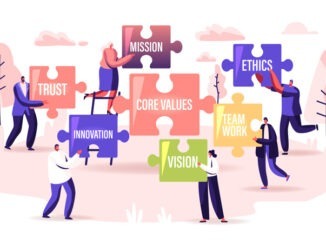
In order to drive sales and let your business be the best it can be, you need to ensure you’re being the best leader possible
CREDIT: This is an edited version of an article that originally appeared on Business News Daily
Employees leave managers, not companies. There are as many management and leadership theories in the world as there are theorists. But it’s fair to say that most workers instinctively look to someone who guides, rather than bosses, and to someone who provides a clear embodiment of a company’s mission and values.
Here are six common leadership weaknesses and how you can fix them.
Common leadership weaknesses
These common leadership weaknesses can hinder a team’s ability to operate effectively. That’s why it’s so important for leaders to regularly self-assess and solicit feedback from their team to ensure they are improving consistently. If you recognise any of these leadership weaknesses in your business, they could represent important opportunities for growth and improvement.
Lack of trust in employees
New leaders often either micromanage employees or take on more tasks than they can handle, all because they don’t trust their teams to perform as well as they do.
“This happens when leaders mistake their role and instead serve as taskmasters or managers in an effort to ensure that things get done,” said Keisha A. Rivers, founder and chief change officer of The KARS Group Ltd. “The best approach is not to micromanage every detail of what has to be done, but to focus on specific outcomes and trusting your team to follow through. Having periodic checkups is best to ensure progress is being made, rather than wanting to be cc’d on every single email or requiring your team to provide daily status reports.”
Heather Monahan, founder of career mentoring group Boss in Heels, added that many managers are afraid to trust their employees with company information, failing to share valuable material with them.
“Deciding to share key pieces of information and watching how your team manages the information is a good recipe for building companywide trust,” she said.
Excessive connectivity
Being connected 24/7 has become a hallmark of the modern mobile workforce. Constant connectivity allows managers to provide feedback on the go and more easily manage workers across time zones, said Nicholas Thorne, CEO of digital badge platform Basno. The problem is that this can lead to an always-connected, omnipresent approach to leadership – and that’s bad for managers and team members alike, he said.
The state of being constantly plugged in can also lead to a malady known as “hurry sickness,” which is defined as the constant need to accomplish more, be faster and multitask everything, even when there is no apparent need to do so. “Hurry sickness” causes leaders and employees alike to get caught up in minutiae rather than standing back and taking in the bigger picture.
Monahan added that overcommitted and overstressed leaders are often inaccessible. You should hold yourself accountable only to reasonable expectations, as stretching yourself too thin will do more damage than good for you and the entire company.
“Creating boundaries and realizing you can’t do it all will allow you to cut back on additional commitments and focus on priorities,” Monahan said.
Stagnancy
All leaders eventually face the danger of getting stuck in their ways. The current way of doing things may be working, but it’s important not to let yourself – or your team – grow stagnant.
“The biggest threat to a successful business is becoming static and losing a desire for innovation,” said Liz Elting, co-CEO of business language services firm TransPerfect.
The best thing you can do for your team as a leader is communicate and instil a clear sense of why you’re doing what you do, Elting said. Your company mission will likely lose credibility without continued innovation, and reminding the organisation of its purpose will motivate you to collaborate and grow.
To stay adaptive, leaders also need to listen to feedback from anyone who has a stake in the business, including clients.
“Their feedback is the most valuable piece of information to the success of your company,” Elting said. “Make it a top priority to not only solicit feedback from them but [also] decipher that feedback and act upon it.”
Needing to be liked
Leaders are people first, and it’s natural that they want to be liked, said David Scarola, chief experience officer of business resource The Alternative Board TAB. But the need to be in everyone’s good favour can sometimes cloud solid business judgment.
“A common mistake with new managers and new business owners is that they make decisions that are popular, which are often not the best decisions for the business,” Scarola said.
“[Leaders] need to sometimes make unpopular decisions. That comes with the territory.”
Instead of trying to be well-liked among your employees, seek instead to be understood and respected. Learn how to communicate openly and frequently with your team, and always keep staff members in the loop about the reason behind any decisions, popular or not.
“The best leaders have learned that if they make the right decisions for their business, even if unpopular, and also take the time to explain their reasoning, they will earn the respect of their employees,” Scarola said. “In the long run, this is the best outcome a leader can aspire to.”
When you’re dealing with performance evaluations, Monahan recommends conducting them based on specific metrics rather than being subjective. You can’t stress over being someone’s friend before being their boss.
Hypocrisy
A “do what I say, not what I do” mentality is toxic to your work environment. As a leader, you set an example for your team. If you want your employees to respect and listen to you, you must follow your own rules. You can’t hold your staff accountable if you aren’t willing to work just as hard.
“A leader must have the utmost and highest level of integrity and model the way for their team,” said Daniel Freschi, president of leadership development company EDGE. “If you leave early during the workday or speak offhand about a colleague, it will likely be repeated by your direct reports.” To avoid this, a leader needs to clarify their values and be hyper aware of their behaviour and hold themselves to the same or higher standards that you would direct reports.
“Leaders often want to create a certain type of environment, but don’t want to actually participate in the culture they are determined to create,” added Monahan. “If you are seeking to create a collaborative environment, ask yourself first if you are collaborating and sharing with others. Putting yourself in everyone else’s shoes will pay dividends.”
You don’t want to isolate yourself from the rest of your team, so don’t be aloof or act like you are better than your employees, Monahan advised. This will only create tension and frustrate employees. It’s better to be open about your flaws with your workers. The more transparent you are, the more authentic your entire team will be.
“By slowly letting others in and sharing failures and challenges, you will begin to appear more real, and employees will begin to believe in you,” she added. “When you make yourself vulnerable, you make yourself relatable.”
Failing to set clear expectations
Employees would rather be instructed on what to do than be left with questions and uncertainty. Providing directions and outlining missions will motivate your team and keep them on track.
“When a leader does not set expectations, their direct reports often limp through their day with no clear direction,” said Freschi. “Direct reports want to be productive; they want to know their work has meaning and is contributing to a bigger picture. Without expectations or goals, they are not able to prioritise the workload.”
While it’s important to trust your workers with their tasks, this doesn’t mean you shouldn’t delegate assignments and highlight objectives to get the ball rolling. Leaders should set individual goals for workers and explain how they align with the broader work of the organisation, Freschi added.
“As leaders, it’s up to you to provide a clear but succinct picture of the vision and desired outcomes for the team and the organisation,” said Rivers. “People connect to a project or task much easier if they know where it’s headed. Don’t keep them in the dark … Determine what information is important and then provide clear instructions and expectations to set them up for success – not failure.”


Be the first to comment